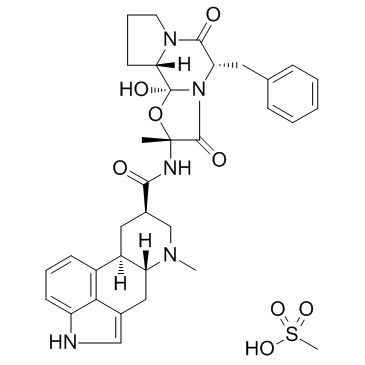Ergotamine tartrate and dihydroergotamine mesylate: safety profiles.
R B Lipton
文献索引:Headache 37 Suppl 1 , S33-41, (1997)
全文:HTML全文
摘要
Ergotamine tartrate (ET) and dihydroergotamine mesylate (DHE) have been widely and effectively used in the treatment of migraine for many decades, although few randomized, controlled clinical trials have been conducted with these compounds. To compare their safety profiles, the world literature on the two agents was surveyed. The results are summarized, along with a critical analysis of the strengths and limitations of the various sources of safety data (in vitro research, animal studies, Phase I and II studies, controlled clinical trials, and postmarketing surveillance). Significant pharmacologic and safety differences exist between ET and DHE. Dihydroergotamine mesylate is a less potent arterial vasoconstrictor than ET, although nearly equipotent as a venoconstrictor. It is a more potent alpha-adrenergic antagonist, but is much less emetic, has less effect on the uterus, and is not associated with rebound headache. Adverse effects associated with ET (which are often due to excessive dosage and/or chronic usage) include nausea, acroparesthesia, ischemia, habituation and overuse headache, and, rarely, overt ergotism. Reports of serious adverse effects following recommended doses of DHE are rare. As with most antimigraine drugs, the most frequent adverse effect with intravenous (i.v.) DHE is nausea; however, following intramuscular (i.m.) or intranasal (IN) administration, the incidence of nausea is low and concomitant administration of an antiemetic is not needed. In patients without contraindications, both DHE and ET are safe and effective when used in recommended doses. Nearly 50 years of clinical experience without major safety problems allows a high level of confidence in their clinical use.
相关化合物
| 结构式 | 名称/CAS号 | 分子式 | 全部文献 |
|---|---|---|---|
 |
双氢麦角胺甲磺酸盐
CAS:6190-39-2 |
C34H41N5O8S |
|
Role of 5-HT1B/1Dreceptors in the reduction of formalin-indu...
2013-06-13 [Life Sci. 92(22) , 1046-54, (2013)] |
|
Structural basis for molecular recognition at serotonin rece...
2013-05-03 [Science 340(6132) , 610-4, (2013)] |
|
Intrapulmonary and intravenous administrations of dihydroerg...
2008-07-01 [Br. J. Pharmacol. 154(6) , 1254-65, (2008)] |
|
Sensitive and specific liquid chromatographic-tandem mass sp...
2002-03-05 [J. Chromatogr. B. Analyt. Technol. Biomed. Life Sci. 768(2) , 267-75, (2002)] |
|
MT 300--POZEN: dihydroergotamine mesylate injection.
2003-01-01 [Drugs R. D. 4(6) , 376-7, (2003)] |